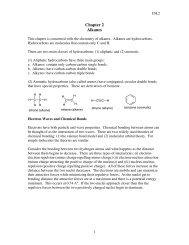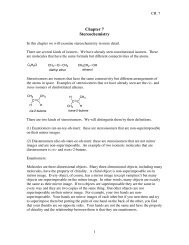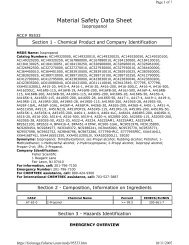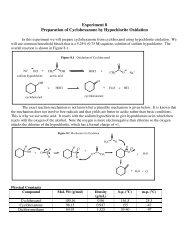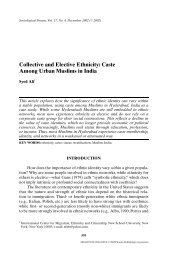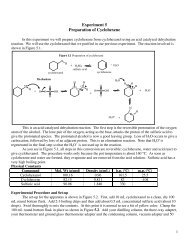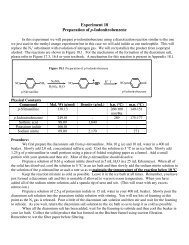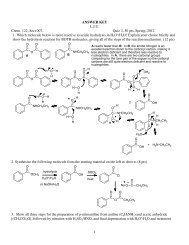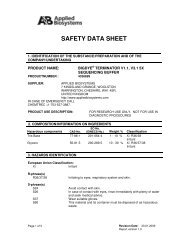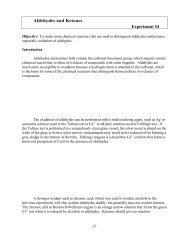Experiment 13 Qualitative Tests for Carbonyls; Unknown ... - myweb
Experiment 13 Qualitative Tests for Carbonyls; Unknown ... - myweb
Experiment 13 Qualitative Tests for Carbonyls; Unknown ... - myweb
You also want an ePaper? Increase the reach of your titles
YUMPU automatically turns print PDFs into web optimized ePapers that Google loves.
Figure <strong>13</strong>.6 Iodo<strong>for</strong>m ReactionROCCH 2H- OHROCCH 2I+ H 2 OIROCHCHI- OH+ I -ROCICHIIROC+IOHRO -CICOH IIOR C- OHICIIROCICHIIIROCHCII- OH+ I -ICIRCOO - +HCI 3Iodo<strong>for</strong>m -yellow solidProcedure:Dissolve 4 drops of a methyl ketone in 1 mL of methanol in a large test tube. Add 1.0 mL of a 10%NaOH solution. Then add KI/I 2 solution drop-wise with shaking until a slight excess of I 2 remains as indicatedby the yellowish or pale brown color of iodine.If 2 mL or more of the KI/I 2 reagent was used, then fill the test tube with water and allow it to stand <strong>for</strong>15 minutes. A yellow precipitate indicates a positive test.If less than 2 mL of the KI/I 2 reagent was used, then it may be necessary to heat the reaction <strong>for</strong> a shorttime (2-3 minutes) at 60 °C in a water bath. If all of the color disappears on heating, then add a few more dropsof the KI/I 2 reagent until the color persists. Fill the test tube with water and allow it to stand <strong>for</strong> 15 minutes. Ayellow precipitate indicates a positive test <strong>for</strong> a methyl ketone but a positive test is also produced byacetaldehyde, CH 3 CHO, and ethanol, which is oxidized by the I 2 to acetaldehyde.Part II Identification of Carbonyl <strong>Unknown</strong>:You will now identify a carbonyl unknown using the tests above and by preparing derivatives of yourunknown and taking the melting points. Your unknown will be one of those carbonyls listed in Table <strong>13</strong>.1 atthe end of this experiment. By comparing the melting points of your unknown derivatives to known valuesreported in the literature (see Table <strong>13</strong>.1) you can identify exactly your unknown compound. You can confirmthis identification by taking the IR and matching it with one of the spectra given in Appendix <strong>13</strong>.1.Procedure:Get a sample of an unknown aldehyde or ketone from the teaching assistant. Your first task is todetermine whether or not it is an aldehyde or a ketone. Per<strong>for</strong>m the Chromic Acid Test, the Tollen’s Test, andthe Iodo<strong>for</strong>m Test. Based on these results you should be able to determine whether your compound is one ofthe aldehydes or ketones and whether you have the methyl ketone [CH 3 C(O)] group.You will now prepare at least two derivatives of the unknown in order to determine its exact identity.Looking at the list in Table <strong>13</strong>.1 you see that there are three possible derivatives that you can use. Begin bypreparing the 2,4-dinitrophenylhydrazone and the semicarbazone. If, however, these two derivatives do notgive you a clear answer, then you will have to prepare the phenylhydrazone derivative. It is recommended thatyou prepare all three derivatives so as to give you extra in<strong>for</strong>mation in helping you make your finalidentification. But note from looking at Table <strong>13</strong>.1 you can see that some of the derivatives <strong>for</strong>m oils rather5



